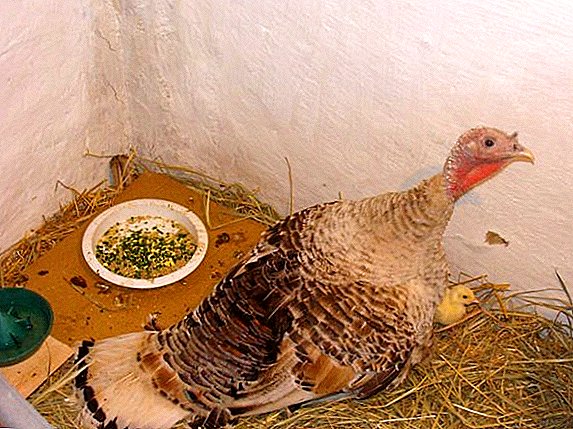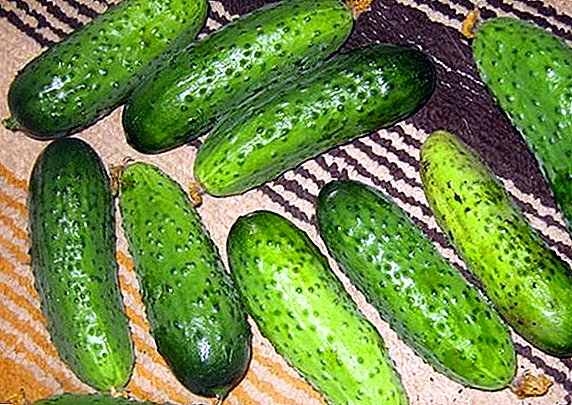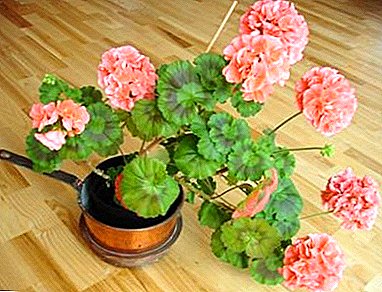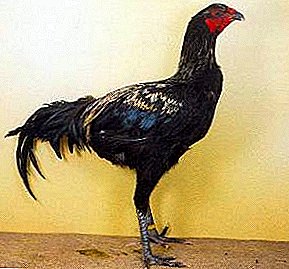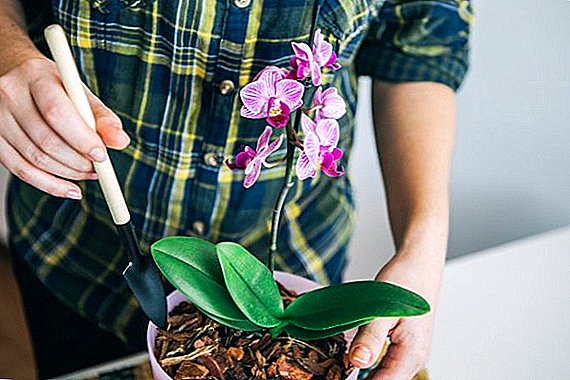 Orchid - one of the most popular indoor crops. Many growers are purposefully engaged in the cultivation of only these flowers.
Orchid - one of the most popular indoor crops. Many growers are purposefully engaged in the cultivation of only these flowers.
For beginners, it will be helpful to familiarize yourself with care recommendations even before buying a plant. How to cultivate orchids and how to properly care for them - read on.
Brief description of the plant
The exact characteristic of each representative orchid species is different. And the general characteristics of these plants are as follows:
- The stem of the plant is strong, depending on the variety can be of different lengths, creeping or straight.
- Leaves are simple in shape. Often 1 leaf grows on the stem. If there are several, they are arranged alternately.
- The roots are basic and subordinate. The main roots are attached to the substrate, take part in photosynthesis and absorb moisture, nourishing the entire plant. Root roots appear in any part of the stem.
- The inflorescences are spikelet or racemes, sometimes solitary. The bud consists of 3 sepals, 2 side lobes and 1 “lip”, which is different from the rest of the flower. After flowering, a fruit box with seeds develops.
Did you know? The name "orchid" in ancient Greek translates as "egg" - due to the fact that the roots of some species of the flower had thickening, similar to this organ in humans and animals.
Rules for caring for a flower at home
The orchid pleases the eye with its flowers of various colors and sizes. For good flowering should care for the plant according to all the rules.
Proper lighting
Orchids of all kinds need a bright diffused light, so you do not need to put a pot with this flower under the direct rays of the sun or, conversely, in a strong shade. Suitable light day for the plant - 11-13 hours. In the case of a short light day, phytolamps from specialty stores will help extend the lighting.

Temperature
Average temperatures for orchids:
- in the afternoon - + 18… + 27 ° С;
- at night - + 13 ... + 24 ° С.
The exact temperature limits florist determined on the basis of the variety of the flower.
| Type of | Kinds | Summer temperature in the afternoon | Winter temperature at night |
| Cold resistant |
| + 22 ° С | + 12 ... + 15 ° С |
| Medium temperature |
| + 18… + 22 ° С | + 12 ... + 15 ° С |
| Heat loving |
| + 15… + 32 ° С | + 15 ... + 18 ° С (daily differential - within + 3 ... + 5 ° С) |
Air humidity
Optimum air humidity for all types of orchids is 60-80%.
Important! Humidity levels tend to fall in the winter when they start to sink in the premises. To increase the humidity of the air to the required level, it is necessary to use a humidifier.
Regular watering
Florists distinguish two ways to moisten orchids.:
- irrigate the substrate from above if the plant is grown in a pot;
- immersed for 4-5 minutes in water if the flower grows in a basket or pot with holes in the bottom and in the walls.
Regardless of the type of irrigation, water should be allowed to drain. This is to ensure that the roots do not rot from excess fluid.

The frequency of watering depending on the season is as follows:
- in the summer - once every 2-3 days;
- in winter - 1 time in 4-7 days.
Pay attention to the look of the plant.
The substrate should dry before the next watering in such orchids:
- oncidium;
- dendrobium;
- cattleya
Other species better tolerate the constant moisture of the bark.
Learn more about the oncidium, dendrobium and cattley orchid care features.
Among them:
- phalaenopsis;
- odontoglossum;
- papiopedilum;
- Cymbidium.
To moisten it is necessary to use water:
- soft;
- separated, thawed or rainy;
- with a temperature of + 23 ... + 25 ° С.
Soil requirements
The basis of the substrate for orchids - tree bark.

For self-cooking, grind and mix the following ingredients:
- oak bark;
- pine bark;
- aspen bark;
- fern roots;
- coal;
- pieces of moss, chalk, foam or peat - optional as an additive.
Fertilization
Fertilizer producers offer special tools for orchids that are suitable for the flower according to the balance of trace elements.
Popular among florists call such:
- Greenward;
- "Pokon";
- "Bona Forte".
Important! Excess fertilizer reduces the resistance of orchids to infections and pests.
It is necessary to feed the flowers only during the period of active growth, the specific season depends on the type of orchid. The recommended frequency of making nutrients indicated in the instructions. Usually the plant is fertilized every 2-3 weeks. However, top dressing does not carry much value for orchids. The flower will have enough useful elements and with regular transplantation into a new substrate.
Plant transplant
The optimal frequency of orchid transplantation is once in 1-2 years. It is better to carry out the procedure when the spring comes and the period of the active growing season of the flower begins. Before transplanting, you must pick a pot. The best option for growers is called a plastic transparent container with holes in the walls and in the bottom.

In such a pot, the rhizome will be saturated with oxygen and sunlight. You can also choose a pot in the form of a basket. Other container options, such as ceramic or glass, are only suitable for professionals who can spend a lot of time caring for the plant.
Orchids should be transplanted as follows:
- Remove the flower from the old container. If the pot is plastic, it is better to cut it - so you will avoid damage to the root system.
- Check for rhizome damage. If there is rot or dried parts, cut them off, and treat the cut sections with crushed coal.
- Pour some bark substrate into a new pot. Carefully straighten the rhizome and cover the rest of the substrate.
- The adaptation period lasts for 7 days. During this period after transplantation, you need to keep the orchid in light shade and not moisturize.
Did you know? Vanilla is the fruit of some orchid species originally from Mexico. For a long time this spice could not be grown in other countries, since the insect pollinating vanilla flowers lived only in Mexico. However, in 1841, a 12-year-old slave from the island of Reunion came up with a method of manually pollinating these flowers. Since then, vanilla has been grown on many continents.
Breeding features
Flower growers multiply orchids in 3 ways: stem offspring, layering and vegetative way. Each method has its own subtleties.
Stem Siblings
The owners of the dendrobium and phalaenopsis can try to propagate the plant with stem shoots. This method is also called dropping off the kids. Children, they are stem shoots, are new shoots that appear on the main stems of orchids.

To propagate the plant in this way, proceed as follows:
- Moisturize the baby from the spray - soon there will be roots and leaves.
- When the root system is visible, carefully cut off the sprout.
- Process cut with powdered coal.
- Transplant stem offspring in a separate pot.
Layering
This method is available for reproduction of some varieties of dendrobium and epidemic rooms. Layers are also called air shoots. When the air otvodok appeared on the stem, you need to prepare a plastic bottle and sphagnum moss - one of them will need to build a mini-greenhouse.
Read more how to propagate an orchid at home.
Step-by-step instructions for breeding by layering:
- Fill the bottle with wet sphagnum.
- Place the layers in the bottle horizontally.
- Maintain a humid warm microclimate in a mini-greenhouse. On average, a month later from the sleeping buds begin to grow shoots.
- When the roots and leaves germinate, separate the new orchid from the mother flower.
- Replant the plant in a pot with a suitable substrate.
- Treat slices with crushed coal.
- Keep a young flower in a mini-greenhouse until it takes root in a new place.
Vegetative way
This method is suitable for adult orchids of almost all varieties.

To propagate a flower vegetatively, you must perform the following steps:
- Remove the plant from the pot.
- Divide the rhizome so that at least 2 pseudobulbs remain on each part.
- Handle cut areas with crushed coal.
- Replant each part in a separate pot with a suitable bark substrate.
- Periodically water the transplanted parts of the flower.
The fact that the plant is rooted, say new stems or leaves.
What problems may arise when growing orchids
When growing orchids there may be some difficulties. The following table lists the most common problems. To get rid of them, it is worth correcting the defects in the care. If necessary, damaged parts of the plant should be removed.
| Symptom | Cause |
| Flabby leaves | High or low temperature, root damage |
| The cracks in the center of the sheet plate | Strong temperature difference, especially after moistening. Damage to the leaves by a foreign object |
| Dark growths or spots | Sunburn |
| The leaves became light green, then yellow and elongated. | Not enough light |
| Leaves wither and shrink | Insufficient watering |
| Root rotting is visible through the holes in the pot, the leaves on the border become yellow | Over-watering |
Much more dangerous than improper care are infectious diseases.

These houseplants have the following diseases:
| Disease | Symptoms | Treatment |
| Brown rot | On young leaves and stems - light brown watery spots that increase and darken over time. | Cut the affected areas, sanitize the slices with crushed coal and process the copper sulphate |
| Black rot | Black spots appear on the orchid | Remove damaged areas, cuts with Bordeaux liquid, transplant the flower into a new pot with a clean substrate |
| Root rot | Roots rot, leaves turn brown | Remove damaged areas, treat root system "Fundazol" |
| Gray rot | Gray patches on leaf plates, substrate and buds, petals covered with brown patches | Treat the plant should "Fitosporin" |
| Fusarium | The leaves turn yellow, curl, wither, become covered with spots, sometimes in pink | To process the flower "Fundazol" |
| Leaf spot | Dark wet spots | Cut diseased leaf plates, process the plant "Fitosporin" |
| Anthracnose | Dark brown spots with clear boundaries, gradually grow and darken | Remove affected leaves, treat with crushed coal, treat the plant with copper sulphate |
| Mealy dew | Whitish patches with scurf on leaf plates and petals, scurf is like sprinkled flour | Treat the plant with the drug "Topsin-M" |
| Viral infection | Light green spots on mosaic-shaped sheet plates, circles, stripes | Cannot be treated, the plant and substrate can be burned, the pot is sanitized |
Pests also significantly affect the condition of the orchid. It is necessary to treat a parasitic plant immediately.
| Pest | Appearance | Treatment |
| Shchitovka | Plaques on leaves and stems with a diameter of up to 0.5 cm with translucent shell | Remove insects from plants mechanically, process "Aktellik" |
| Aphid | Insects with a length of 2-3 mm, often light green, attached to the leaf plates on the bottom side | Remove pests with a sponge moistened in soap solution, treat leaves with Chlorophos |
| Mealybug | White scurf on leaves, stalks and buds under which insects hide | Remove worms and plaque with a damp cotton swab, treat the plant with "Fitoverm" |
| Spider mite | Cobweb on the leaves, often from the bottom, and on the petals | Wash off plaque, treat with Tiofes or Neoron insecticide |
| Thrips | Grayish film-like plaque, dot-like damage on the lower part of leaves, pests often hide among bark particles in the substrate | Rinse the plant, process "Fitoverm" or "Aktellik" |
| Poddur | Gray insects live in a wet substrate | Dry the bark or transplant the orchid into a new substrate, process it with "Fitoverm" |
| Nematode | Light worms up to 0.2 cm long. With the defeat of the leaves change shape, growth slows down, there are fewer flowers, spots appear, pseudobulbs form necrosis, and rhizomes swell. Rarely appears on orchids | Remove from other indoor plants, rinse under water + 40 ° C and above, process the soil "Dekarisom." If no change, destroy the orchid |
Useful tips
Experienced growers claim that it is not at all difficult to care for an orchid at home.
However, so that it always blooms well and is healthy, it is advisable to adhere to some tips on growing it:
- boil bark before preparing the substrate to get rid of possible infection or pests;
- water the flower in the morning;
- after flowering, some flower growers are advised to trim the old flower spike a few centimeters higher than the second bud;
- It is possible to transplant a blooming orchid only in emergency cases, for example, in case of illness - it is better to have a healthy plant transplanted between flowering plants.
Read also whether it is possible to reanimate an orchid if the roots have rotted.
Growing orchids in room conditions is not difficult if you know all the details of flower care. Establish the correct microclimate, water it properly, repot it in time - and then the plant will please the owner for a long time with beautiful flowering.


